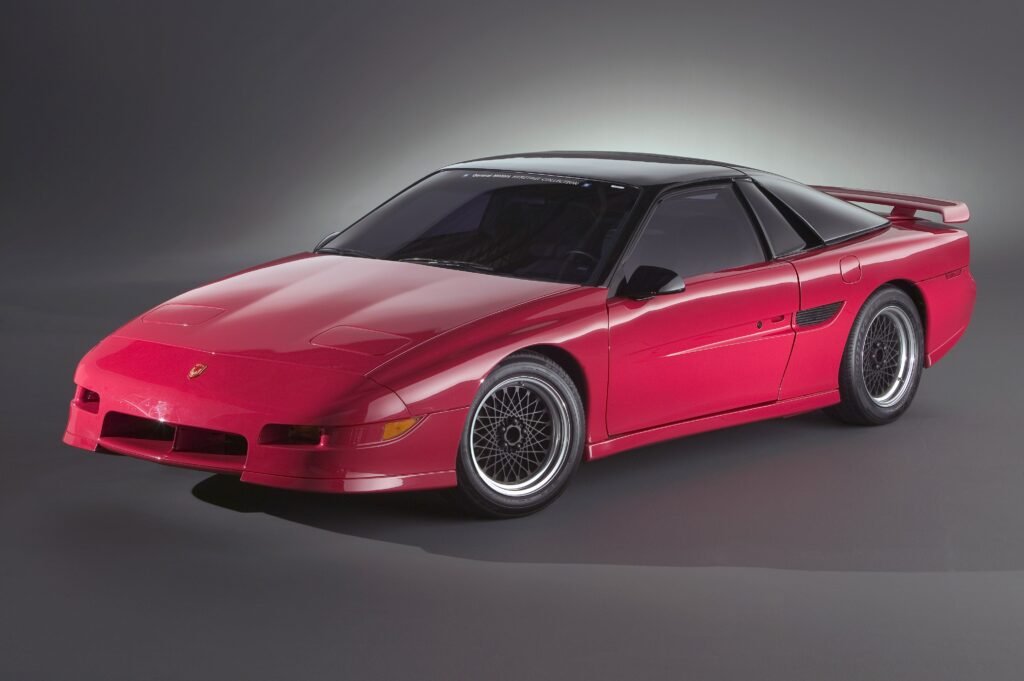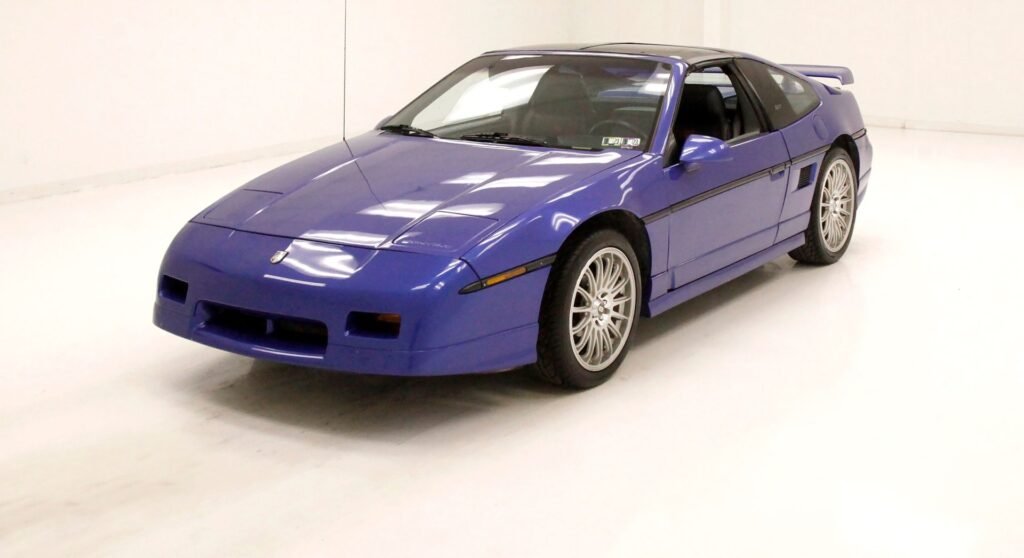The first mass-produced automobile in North America with a mid-engine layout was the Pontiac Fiero, which was built from 1984 to 1988. Sales were only supposed to reach 18,000 units over two years due to production expenses, despite the car’s original goal of being an inexpensive sports car.
The Fiero’s high production costs prevented it from being widely popular, even with its distinctive and enthusiast-favored mid-engine design. The Fiero has a unique place in automotive history because of how much its characteristics and design have been compared to classic vehicles like the Ferrari 308 GTB.
Pontiac Fiero Overview
Originally intended to be a compact, two-seat sports vehicle with a V6 engine and a completely redesigned suspension, the Pontiac Fiero debuted in 1984. Young Pontiac engineers successfully marketed the Fiero concept as a fuel-efficient four-cylinder “commuter car” with two seats, overcoming worries about competition with the Corvette, despite resistance from General Motors management to invest in a second two-seater sports car.
In less than six months, the engineers quickly created a functioning prototype, winning approval for mass production. Taking advantage of the oil crisis, the Fiero used GM’s 2.5 L four-cylinder Iron Duke engine, which is fuel-efficient, to create a sporty commuter car that is also economical. Hulki Aldikacti was given the project by Pontiac, but he ran into financial difficulties and issues with GM’s organizational structure.

The Fiero’s distinctive appearance and cost-cutting strategies helped it earn a special place in GM’s portfolio despite sacrifices. By lowering vehicle weight and aerodynamic drag, the mid-engine arrangement improved handling and fuel economy. Although the Fiero’s handling was praised, it was criticized for falling short of what was expected of it due to its mid-engine setup, which should have produced more performance.
The need for extra power prompted Pontiac to launch the GT model with a V6 engine in 1985, as the oil crisis subsided. Despite design advancements, GM discontinued production in 1988 as a result of falling sales. The Fiero is still regarded as a classic from the 1980s because of its distinctive style and reasonable price.
Pontiac Fiero Key Features
- Fuel type: Petrol
- Engine displacement: 2827 cm3 / 172.5 cu-in V 6
- Horsepower: 142 PS / 140 HP / 104 kW
- Maximum torque: 230.0 Nm / 169 lb-ft
- Top Speed: 180 km/h / 112 Mph
Pontiac Fiero Design
Pontiac Fiero Engine:
- The Fiero was built by General Motors’ Pontiac subsidiary from 1983 and 1988. It had two engine options at first: a 2.5 L four-cylinder or a 2.8 L V6.
- The first model, created by George Milne, Jr., was displayed at the Detroit Auto Show in 1981.
- The larger 3.1 L V6 engine was made available as an option for the 1985 model.
- The suspension consists of a live rear axle with semi-trailing arms and coil springs, as well as an independent front suspension with coil springs and a stabilizer bar.
Pontiac Fiero Interior:
- The Pontiac Fiero saw a drop in popularity over time despite being initially hailed for its affordable price and athletic appearance.
- Even with criticism from the outside, the interior is still shockingly roomy and comfy.
- There is plenty of head and legroom, spacious and adjustable seats, and an elegant dashboard with clearly accessible controls.
- Ample storage space encompasses a sizable glovebox, a section beneath the radio, and a compact trunk.


Pontiac Fiero Exterior:
- The 1984 Pontiac Fiero is a two-seater sports automobile with a V6 engine that is well-known for its distinctive and elegant styling.
- The exterior has a sporty look, a low-to-the-ground profile, and a noticeable spoiler on the back.
- Drivers can select the Fiero based on their preferred style thanks to its assortment of colors.
- Even while the Fiero may not be among the most popular cars on the road today, its striking look is guaranteed to draw attention.
Pontiac Fiero Pros And Cons
Pros:
- Iconic 80’s Sports Car:
- The Fiero’s classic style, which embodies the spirit of 1980s sports vehicles, adds to its appeal.
- Resurgence in Popularity:
- The Fiero has seen a comeback in popularity among collectors and enthusiasts in recent years.
- Ideal Vintage Project Car:
- The Fiero is a great option for old-project cars because it provides a special fusion of contemporary performance and traditional looks.
- Attractive Design:
- The Fiero stands out as a viable choice for auto restoration efforts because of its timeless style.
- Affordability:
- The Fiero offers a reasonably priced entry point into the field of vintage automobile repair.
- Widely Available Parts:
- Parts for the Fiero are still widely available, simplifying the restoration process and ensuring accessibility for enthusiasts.
- Modern Performance Potential:
- Despite its vintage charm, the Fiero offers the potential for modern performance upgrades, catering to enthusiasts seeking a balance between classic and contemporary.
- Rewarding Project Experience:
- While not the easiest car to work on, restoring a Fiero can be a rewarding and enjoyable project for those passionate about automotive craftsmanship.
Cons:
- Poor Fuel Economy:
- Engine design issues led to subpar fuel efficiency, causing dissatisfaction among owners.
- Proneness to overheating further compounded fuel economy challenges.
- Corrosion Troubles:
- The Fiero faced criticism for being susceptible to corrosion, affecting its overall durability.
- Lack of Power:
- Notorious for its underwhelming power, the Fiero disappointed drivers seeking a more robust performance.
- Electrical Problems:
- Suffering from electrical issues, the Fiero experienced reliability concerns that affected its overall functionality.
- Stiff Suspension:
- Criticized for an excessively stiff suspension, the Fiero’s handling capabilities were compromised, making it challenging for drivers
Pontiac Fiero For Price
The all-new Discovery, which rivals the Mercedes GLS, BMW X5, Volvo XC90, and Audi Q7, is priced between $61,250 and $80,650 and represents a new generation of vehicles with a modern, roomy, and beautiful appearance.
- P300 S – $61,250 MSRP
- P300 Dynamic SE – $65,450 MSRP
- P300 Dynamic SE (Most Popular) – $71,250 MSRP
- P300 Metropolitan Edition – $80,650 MSRP
Pontiac Fiero Car Review
Although the previous Land Rover Discovery (LR4) had performance issues, it was improved to keep up with modern trends and rival vehicles while retaining its off-road and family-friendly qualities. My Disco II is still going strong after 3.5 years and 35,000 miles. Minor problems are quickly resolved by the dealership, and other Land Rover owners have also experienced similar great experiences. The vehicle is dependable for both business trips and off-road exploration.

Frequently Asked Questions [FAQs]
What is special about the Pontiac Fiero?
The Pontiac Fiero stands out with special features. It employed 4- and 6-cylinder engines, aiding Pontiac in meeting America’s fuel economy standards. Notably, the Fiero’s innovative use of non-load-bearing composite body panels added to its lightweight design, making it distinct and appealing.
How much is a Pontiac Fiero worth today?
A: The average price is $12,515.
Was the Pontiac Fiero a fast car?
Yes, the Pontiac Fiero showcased speed with the SD4 engine, reaching over 138 mph (222 km/h) in the 1984 Indy Fiero Pace Car during the race.
The Bottom Line
The Pontiac Fiero was a remarkable vehicle with a cutting-edge mid-engine configuration and a distinctive look. It defined the sports car market in the US and was Pontiac’s first two-seater sports car, leaving an enduring legacy. In addition to having distinctive features, the Fiero served as a model for other Pontiac vehicles such as the Trans Am and Firebird. The Fiero is regarded as a classic car today and has a big role in the history of automobiles.
Read More:
Unveiling The Top 5 Most Luxury Cars of 2024

